Johor-Singapore SEZ: Pengerang’s potential as hub for 'spillover' business renews optimism for area’s development
Economists said that accessibility between Pengerang and Singapore as well as the rest of southern Johor must first be improved for the area to fulfil its investment potential.

Oil storage tanks within the Pengerang Integrated Petroleum Complex (PIPC). (Photo: CNA/Zamzahuri Abas)

This audio is generated by an AI tool.
KOTA TINGGI, Johor: Tucked away in the southeastern tip of peninsular Malaysia is a large swathe of land with rows upon rows of oil storage tanks and cooling towers with dark smoke billowing from above.
The Pengerang Integrated Petroleum Complex (PIPC) - which stretches across more than 20,000 acres of land and about the size of more than 15,000 football fields - is Malaysia's biggest refining and petrochemical complex and has been touted by economists as potentially a regional oil and gas hub.
The complex forms a significant part of Pengerang, a municipality in the Kota Tinggi district in southern Johor. The area is also known for tourism - encompassing the Desaru Coast chain of hotels which draws visitors from Singapore, as well as Sungai Rengit, a town known for cheap seafood and its rustic fishing village atmosphere.
Industry experts told CNA that a large part of Pengerang is undeveloped land and that this could soon change in the short term given the area’s possible inclusion as part of the Johor-Singapore Special Economic Zone (SEZ).
The vast amount of land space in Pengerang could serve as a hinterland for the expansion of oil and gas companies from the Republic while the possible revival of a renewable solar energy farm project may have the potential to increase collaboration between Malaysia and Singapore.
During a Johor state assembly sitting on May 12, chief minister Onn Hafiz Ghazi said that the state government is proposing that the geographical scope for the area within southern Johor to be gazetted for the SEZ to encompass a land mass of 3,505 square kilometres.
This is more than four times the size of Singapore.
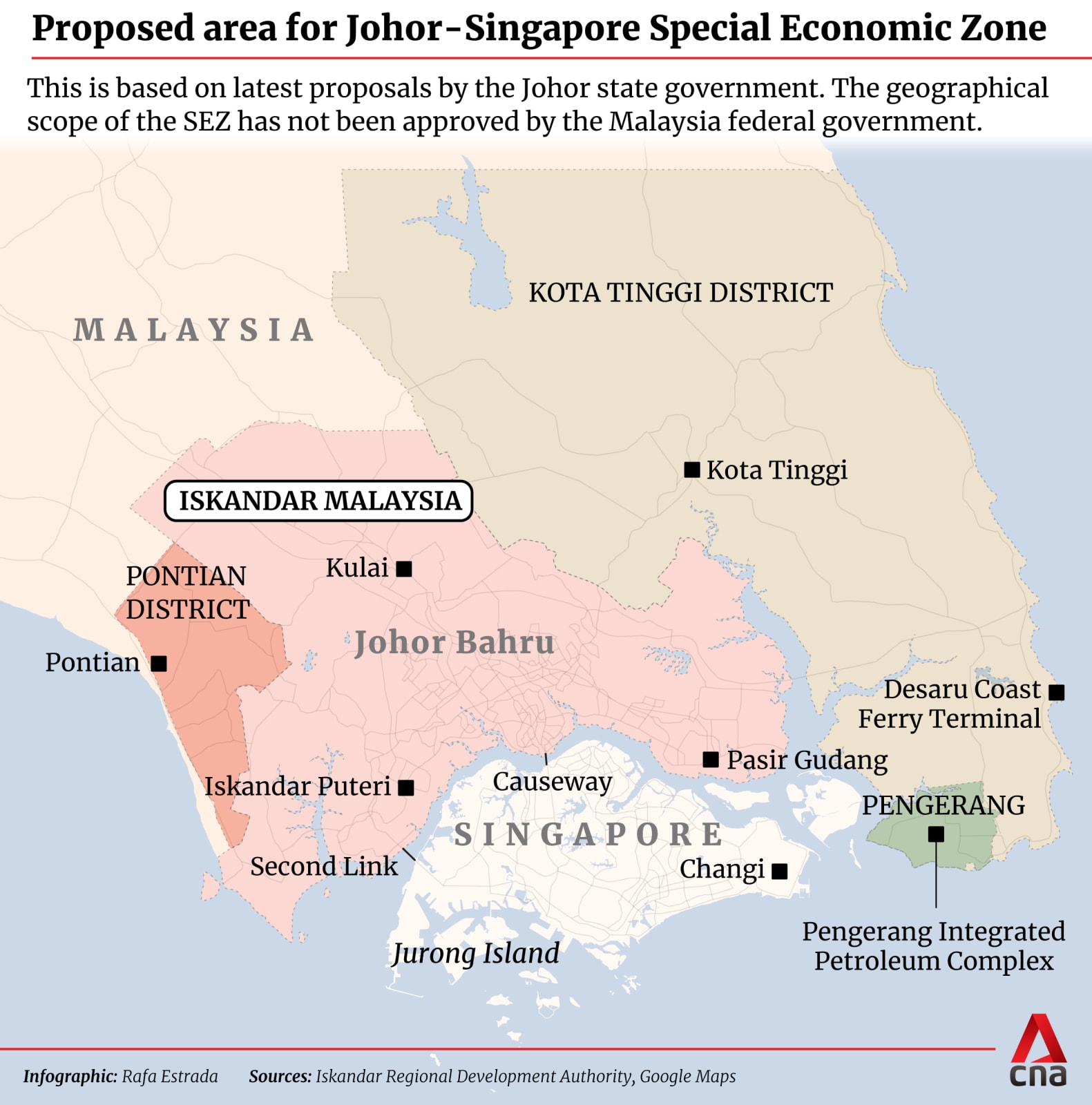
He added that the proposed area would span across six districts - Johor Bahru, Iskandar Puteri, Pasir Gudang, Pontian, Kulai and Kota Tinggi.
“(We are) putting forward Iskandar Malaysia and Pengerang as the locations of the SEZ,” said Mr Onn Hafiz in summary.
The Iskandar Malaysia project was first conceptualised in 2006 by the Malaysia government led by then-prime minister Abdullah Ahmad Badawi, and was a vision to rejuvenate Johor into a key investment destination.
Iskandar Malaysia spans across four major districts in the southern state - Johor Bahru, Iskandar Puteri, Pasir Gudang and Kulai.
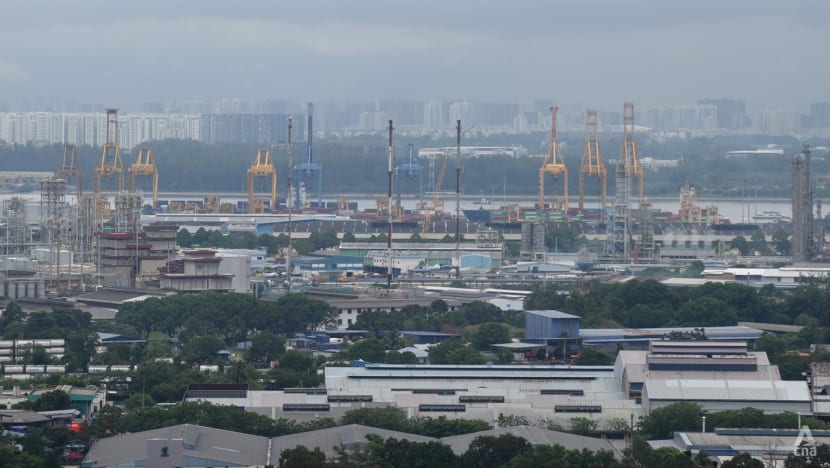
While the progress for the Iskandar Malaysia project was halted due to longstanding issues on connectivity and lack of political will, there is renewed optimism that the upcoming SEZ will take off and transform southern Johor into an investment metropolis.
And even though the proposal by the Johor state government for the geographical scope of the SEZ has not yet been approved by the federal government and the Singapore government, the inclusion of Pengerang at this stage of discussions has piqued interest given the area’s potential to boost Malaysia’s collaboration with Singapore in the petrochemical industry as well as the field of renewable energy, analysts said.
However, some stressed that accessibility in and around Pengerang to connect the area to Singapore as well as other parts of the SEZ is paramount to ensure that the area is a viable investment destination.
Dr Shankaran Nambiar, head of research at the Malaysian Institute of Economic Research told CNA that Pengerang is being earmarked to become a key oil and gas hub, and stressed that it is “not a location that can be ignored”.
“Downstream petroleum-based industries are planned for the area. The municipality will be the site for refineries, petrochemical plants and storage facilities. The next phase of development in Pengerang is expected to see elements of sustainability come into play, blending in green energy,” said Dr Nambiar.
“One can expect there will be a great deal of economic activity and traffic movement in Pengerang. There is no doubt that connectivity of the area will improve. It has to, if the investment and commercial potential are to increase,” he added.
PENGERANG COULD SERVE AS HINTERLAND FOR OIL COMPANIES IN SINGAPORE
A representative of the Johor state government Mr Lee Ting Han told CNA that the PIPC itself - a massive oil refining and petrochemical project - could allow Malaysia to leverage its industrial infrastructure and attract related investments for the upcoming SEZ with Singapore, especially with both countries having committed to net-zero carbon emissions in around 25 years.
“We also note the global trend in relation to Net Zero Carbon Emissions by 2050 which puts pressure on this industry. Having Pengerang included in the SEZ may help to work out collaboration efforts between Malaysia and Singapore to achieve the goal whilst allowing the industry to grow via mechanisms such as carbon capture,” said Mr Lee, who is Johor investment, trade, consumer affairs and human resources committee chairman.
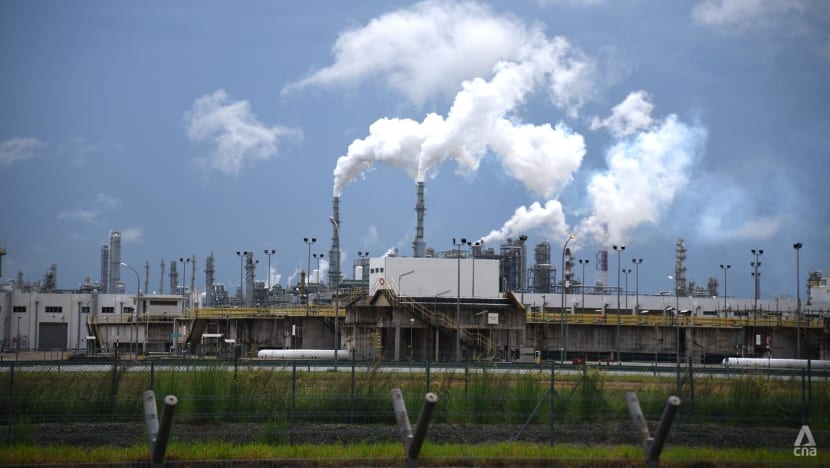
“Furthermore, Pengerang's proximity to Singapore makes it feasible to integrate infrastructure and logistical networks, reducing transit times and costs for businesses,” he added.
According to the International Energy Agency, the Net Zero Emissions by 2050 Scenario is a normative scenario that shows a pathway for the global energy sector to achieve net zero carbon dioxide emissions by 2050, with advanced economies reaching net zero emissions in advance of others.
When the PIPC was first announced in 2011, it was dubbed “Rotterdam of the East”, in reference to comparisons to the world’s largest petroleum and gas hub in the Netherlands.
The goal was for PIPC to attract more than RM330 billion (US$70.14 billion) in investments. According to local media reports, in spite of setbacks such as the COVID-19 pandemic and several fire incidents in the complex, PIPC has completed its first phase of development and is on track to meet and exceed its targets by 2025.
PIPC is home to Malaysia’s government-owned energy firm Petronas and has also attracted investments from the world’s largest oil and gas complex operator the Netherlands’ Royal Vopak Group as well as Saudi Aramco, one of the world's largest integrated energy and chemicals companies.
Associate Professor Lee Poh Seng, executive director with the Energy Studies Institute (ESI) at the National University of Singapore (NUS) told CNA that PIPC provides extensive facilities for refining and petrochemical activities, offering an alternative space for expansion for Singapore companies.
Singapore is already entrenched as a regional leader in oil and gas and is among the world’s top three refining centres. Jurong Island, the city state’s massive oil and gas complex, has drawn investments from various companies including Shell and ExxonMobil.
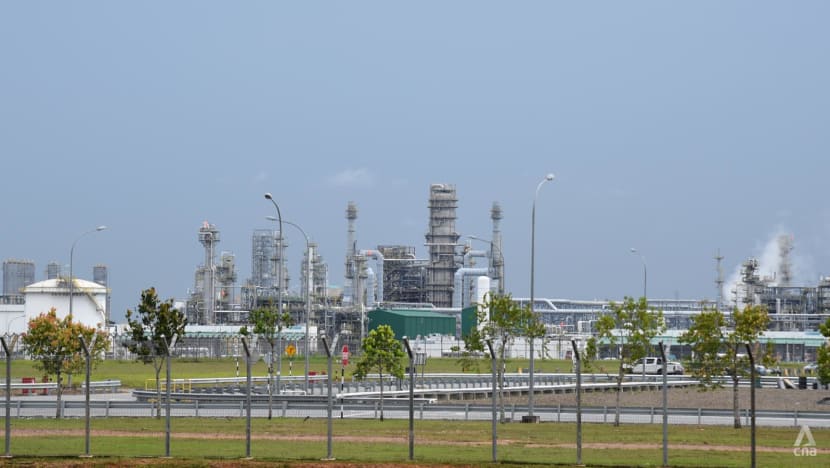
However, land is getting scarce on Jurong Island and industry watchers said that there is a limit to how much expansion it can handle, and hence Pengerang could benefit from spillover of business from Singapore.
“Pengerang has the potential to serve as a hinterland for oil companies in Singapore,” said Assoc Prof Lee.
“This can help alleviate the space constraints faced by Singapore’s oil infrastructure and support operational efficiency through its proximity and robust logistics infrastructure,” he added.
A SOLAR FARM TO BOOST RENEWABLE ENERGY EXPORTS?
Another sector that could develop in Pengerang with its inclusion in the planned SEZ is the renewable energy industry.
In 2020, Johor ruler Sultan Ibrahim Sultan Iskandar mooted the possibility of building a 450-megawatt (MW) solar photovoltaic power project - dubbed the Sultan Ibrahim Solar Photovoltaic Park.
It was envisioned to be Southeast Asia’s largest solar energy storage system.
However, in March 2021, Sultan Ibrahim announced on his Facebook page that an official ground-breaking ceremony for the project had been cancelled as the federal government had “not given any response” to the proposed project.
“I don’t see any reason why the federal government would not be willing to give Johor a chance to be an eco-friendly producer of electricity. We have a suitable plot for the project, robust growth and development, as well as a healthy demand from our neighbour, which makes Johor a most strategic location,” wrote Sultan Ibrahim.
Economists have suggested that now with Sultan Ibrahim as the newly installed Malaysian king, there is likely more political will for the project to proceed.
A report by Malaysia Institute of Economic Research stated that as of February 2024, the project is still in the process of getting approvals and “expected to get commissioned at the cost of RM1.4 billion”.
Mr Brian Lee, an economist with Maybank securities, told CNA that a possible revival of the project might boost the renewable energy Malaysia could export to Singapore.
“Surplus energy generated by the Sultan Ibrahim Solar Photovoltaic Park may be sold to Singapore,” he said.
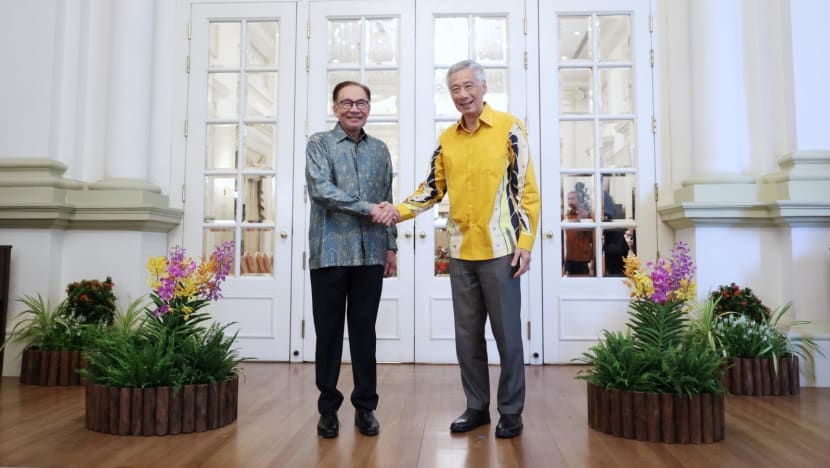
In October 2023, during the Singapore-Malaysia Leaders’ Retreat, then-prime minister of Singapore Lee Hsien Loong and his counterpart Anwar Ibrahim outlined a willingness to collaborate on renewable energy.
Mr Lee said then that both countries are moving towards a low-carbon and sustainable future, and they are pursuing cross-border electricity trading, which will be a win-win partnership for both countries.
Among others, the Borneo state of Sarawak is looking to become a major exporter of green energy. According to reports, it aims to provide up to one gigawatt of renewable energy to Singapore by 2032. Its state minister has told local media previously that this export of electricity to the Republic will not affect the supply of its own domestic consumption.
Meanwhile, the Johor state government representative Mr Lee told CNA that collaboration in the field of renewable energy and green technology is specially mentioned in the memorandum of understanding between Malaysia and Singapore on the SEZ.
“The inclusion of Pengerang presents an opportunity to integrate renewable energy sources such as solar, biomass and potentially hydrogen into the industrial infrastructure, as it has advantage in terms of land and infrastructure availability as well as other resources,” he added.
NUS’ Assoc Prof Lee shared similar sentiments, highlighting how Pengerang’s “ample land and high solar insolation” makes it an ideal location for solar energy projects.
Solar insolation refers to the amount of solar radiation received on a surface over a period of time.
“Johor’s state government has shown interest in diversifying its energy portfolio, with plans to develop solar farms as part of the third phase of the PIPC development. This aligns with global trends towards sustainable energy solutions and could attract investments from companies focusing on renewable energy,” he added.
IMPROVING ACCESSIBILITY
While there is optimism about Pengerang’s potential to be an oil and gas hinterland for companies in Singapore, some experts warn that the accessibility to the area must be improved to facilitate the smooth flow of workers and cargo.
Via the Senai-Desaru highway, Pengerang is a 80-minute drive from Johor Bahru city centre and the Woodlands Causeway, considered a long journey from Singapore as compared to other industrial areas in the planned SEZ.
There are ferry services between Tanah Merah in Singapore and Desaru Coast in Pengerang, but the frequencies and services are catered for tourists.
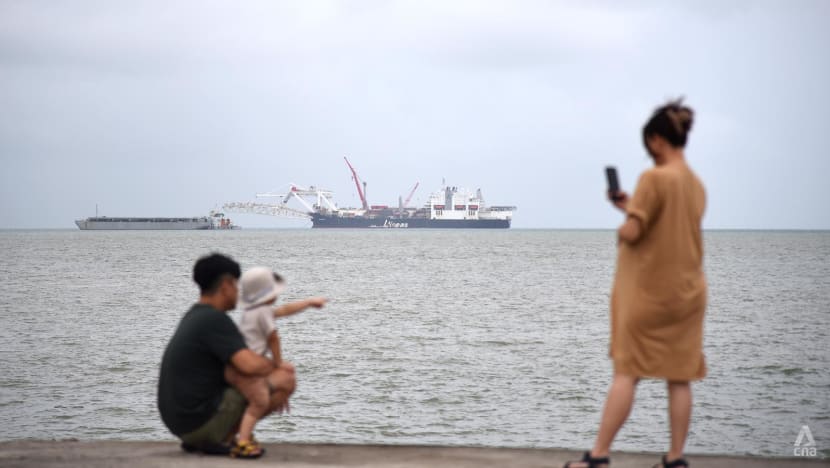
NUS’ Assoc Prof Lee told CNA: “Improving accessibility to Pengerang is crucial for the success of the SEZ. Better connectivity would facilitate the movement of people and goods, making Pengerang more attractive to investors and integrating it more effectively into the broader economic activities of the SEZ.
He suggested that given the large distance between Pengerang and the land checkpoints, it would be better to increase ferry services between Singapore and ferry terminals in the municipality such as in Tanjung Pengelih.
Maybank’s Mr Lee agreed, explaining that “the most direct way” to connect Pengerang and Singapore is via sea.
“The frequency and passenger capacity remains relatively limited, and has scope to be ramped up,” he said.
The Johor state government’s Mr Lee said that authorities are discussing ways to improve connectivity to Pengerang.
“We have announced the expansion of the Senai-Desaru Highway which is expected to commence in September this year. Ferry services between Desaru and Tanah Merah, Singapore are also well received by tourists,” he said.
“Going forward, we are open to having more services connecting other areas of Pengerang to Singapore.”


















